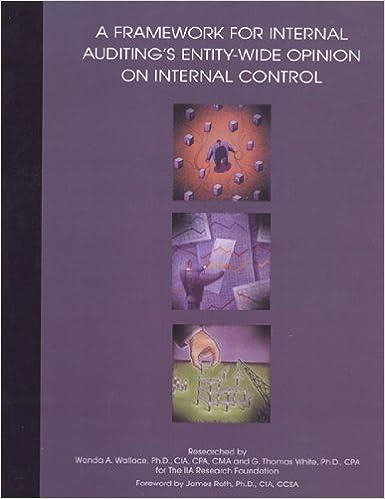Question
27. If a firm borrowed money on a six-month bank loan, the firm's working capital immediately after obtaining the loan, relative to its working capital
27. If a firm borrowed money on a six-month bank loan, the firm's working capital immediately after obtaining the loan, relative to its working capital just prior to the loan, would be: A. Higher. B. Lower. C. The same. D. Would depend on the amount borrowed.
28. Which of the following accounts is part of working capital? A. Retained Earnings B. Sales C. Merchandise Inventory D. Common Stock
29. To accrue $5,500 of employee salaries for the last week of February, the employer's journal entry is: A. B. C. D.
30. Sage, Inc. has 20 employees who each earn $100 per day and are paid every Friday. The end of the accounting period is on a Wednesday. How much wages should the firm accrue at the end of the period? A. $2,000. B. $1,000. C. $0. D. $6,000.
31. Which of the following is not one of the 5 questions of transaction analysis? A. What's going on? B. Which accounts are affected? C. Is this an accrual? D. Does the balance sheet balance? E. Does my analysis make sense?
32. The effect of an adjustment is: A. To correct an entry that was not in balance. B. To increase the accuracy of the financial statements. C. To record transactions not previously recorded. D. To close the books.
33. A journal entry recording an accrual: A. Results in a better matching of revenues and expenses. B. Will involve a debit or credit to cash. C. Will affect balance sheet accounts only. D. Will most likely include a debit to a liability account.
34. Wisdom Co. has a note payable to its bank. An adjustment is likely to be required on Wisdom's books at the end of every month that the loan is outstanding to record the: A. Amount of interest paid during the month. B. Amount of total interest to be paid when the note is paid off. C. Amount of principal payable at the maturity date of the note. D. Accrued interest expense for the month. Martin & Associates borrowed $5,000 on April 1, 2010 at 8% interest with both principal and interest due on March 31, 2011.
36. How much should be in the firm's interest payable account at December 31, 2010? A. $300 B. $400 C. $0 D. $333
37. Which of the following journal entries should the firm use to record the payment of interest on March 31, 2011? A. B. C. D.
38. The accountant at Abco, Inc. made an adjusting entry at the end of February to accrue interest on a note receivable from a customer. The effect of this entry is to: A. Decrease ROI for February. B. Increase ROI for February. C. Decrease working capital at February 28. D. Decrease the acid-test ratio at February 28.
39. The accounting concept/principle being applied when an adjustment is made is usually: A. matching revenue and expense. B. consistency. C. original cost. D. materiality.
40. The Interest Receivable account for February showed transactions totaling $8,500 and an adjustment of $11,200.All of the following responses are correct except: A. The transactions probably resulted from accruing interest income earned. B. The transactions were probably entered on the credit side of the account. C. The adjustment was probably for cash receipts of interest receivable accrued in prior months. D. The balance in the interest receivable account decreased $2,700.
41. The balance in the Accrued Wages Payable account increased from $12,200 at the beginning of the month to $15,000 at the end of the month. Wages accrued during the month totaled $61,000. A. Wages paid during the month totaled $58,200. B. Wages paid during the month totaled $64,800. C. Wages expense for the month totaled $58,200. D. Wages expense for the month totaled $76,000.
Step by Step Solution
There are 3 Steps involved in it
Step: 1

Get Instant Access to Expert-Tailored Solutions
See step-by-step solutions with expert insights and AI powered tools for academic success
Step: 2

Step: 3

Ace Your Homework with AI
Get the answers you need in no time with our AI-driven, step-by-step assistance
Get Started


